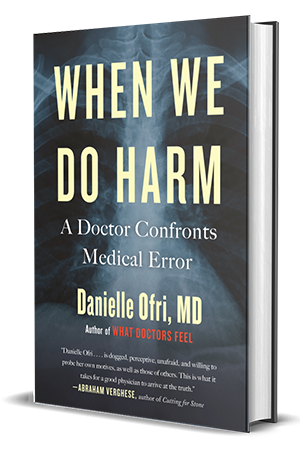Book Excerpt: EMR–Boon or Bane?
Excerpt from “When We Do Harm”
Published on KevinMD
One of the selling points for the electronic medical record (EMR) was that it would be a boon for patient safety. Just having all the medical records in one place is a monumental improvement over the days of lost charts and misplaced X-rays. Avoiding errors from inscrutable handwriting has no doubt saved lives.
But EMRs can also worsen medical care and introduce errors. Cumbersome usability forces staff to take shortcuts that can be dangerous. Diagnosis codes that are driven by billing requirements distort the diagnostic process and can lead to diagnostic error. Copy-and- paste ability leads to voluminous notes that resemble those online “terms of service†agreements that you surely read assiduously.
By far the biggest landmine for medical error and patient harm is the automated alert system. For doctors and nurses, these computerized alerts constitute one continuous, communal migraine. The EMR alert system has become an octopus of misery, swatting unceasingly from all directions. Just when you think you may have cleared the gauntlet of alerts, another seven bulbous legs come whipping at you with more alerts to navigate.
It makes me crazy—and livid—because buried within the morass of useless alerts are some important ones that I can’t afford to miss. Besides, the EMR is a legal document. Clicking “okay†to an alert indicates that I’ve read it, evaluated its contents, considered its impact, and then made a decision. That’s certainly what a lawyer would say in court.
I decided, one day, to commit myself to reading every single alert before I dismissed it. I set to work that morning, feeling like a boxer newly motivated in the ring, bobbing confidently, flexing my newly invigorated patient-safety muscles. I could almost feel the satiny robe glittering around my shoulders instead of my saggy white coat with ink stains from a leaky pen. I was ready for battle!
Let’s just say I didn’t even make it through the first round. I was defeated with my very first patient of the day. He needed thirteen prescriptions and these generated dozens of alerts. Nearly all were useless. My patient committed the cardinal sin of being over sixty-five, so every single one of this thirteen prescription was accompanied by an individual warning that I needed to “prescribe with caution.†There was “weight-based dosing not available†for a medication that doesn’t need to be adjusted for weight. Then there were the alerts that seemed possibly important but were couched in murkiness: “Drug X may increase bio-availability of drug Y. Quality of data uncertain.†What the heck was I supposed to do with that?
It’s clear that the first priority of the system is attending to liability rather than to patient care. If they’ve posted every possible warning, no matter how lame, then they—the hospital, the EMR, the greater universe—cannot be held at fault if something goes wrong. It’s that pathetic doctor who clicked “okay†to the warnings who is at fault.
The whole alert system feels like a transfer of blame—not to mention workload—onto the medical staff. Doctors and nurses have no other option but to plug through the sea of alerts because we have to get the medications to our patients. It’s estimated that primary care doctors spend a full hour per day just responding to alerts. Are patients actually better off? I’m not so sure.
One day, I was plowing through my endless in-basket of test results. I came upon the A1C (average glucose) of my patient, Mr. Portero.* It was still astronomically high, despite his elephantine doses of insulin. His decades of diabetes had already cost him one leg and most of his vision. His kidneys had taken a hit and I worried that dialysis could be lurking on the horizon.
Before I called him about these lab results, though, I needed to review his chart to remind myself about our last insulin adjustments. Because of his obdurate diabetes and its cascading complications, Mr. Portero was a prodigious user of the medical system. His electronic chart reflected that and took longer to load. Spending even thirty seconds staring at a whirling graphic while there is so much more work to do sends me into a tizzy, so while Mr. Portero’s chart was loading, I moved on to the labs of the next patient.
Mr. Jalloh* had been diagnosed with diabetes only a year ago, and he was in the throes of completely retooling his life. He’d dumped the white rice, which had been his daily manna. The goat stew was gone. The syrupy baklava was history. Fanta orange soda had been excised. He now whipped up “green juice†daily and was a legume poster child. When he was diagnosed the year before, he’d required two medications to control his diabetes. But now we’d been able to discontinue one of them and were in the process of weaning him off the second.
Mr. Jalloh’s youthful medical chart loaded much more quickly than Mr. Portero’s, so I decided to call him first. “Great news!†I said. “Your sugar is staying down nicely. I think we’ll be able to stop your medications completely.†With a disease like diabetes, we don’t often have unadulterated good news to relay to our patients, so this type of phone call is as rare as it is thrilling.
Mr. Jalloh was clearly elated too. “That’s fantastic,†he practically sang into the phone. “This is the first time I’ve ever gotten good news about my sugar!â€
First time?
“You really made my day, Dr. Ofri! I can’t wait to dump all my syringes into the trash. Goodbye, insulin!â€
Syringes? Insulin? Uh-oh.
I realized I had accidentally dialed insulin-dependent, amputated, obese, wheelchair-requiring, nearly blind Mr. Portero, not lentil-toting, kale-convert, rail-thin Mr. Jalloh. (Only in the sterile digitized world of the EMR could two patients so vastly different be confused for each other.)
It was one of my lowest moments as a doctor. First I had to tell Mr. Portero that I’d made a mistake, mixing him up with someone else. And then I had to tell him that the good news was a false alarm. His sugar wasn’t low at all; it was depressingly high and we’d need to increase his insulin.
I’d fallen into the trap of having two charts open at the same time. It’s easy to say that I was just being stupid. It’s a complete no-no to have two charts open at the same time—I know that! I warn my interns and students about this till I’m blue in the face.
And yet here I was doing it, and making a dangerous error because of it. I could easily have accidentally prescribed Mr. Jalloh’s pills to Mr. Portero and sent them electronically to his pharmacy. Mr. Portero could easily have taken them (he was on so many pills that changed so often that he might not have noticed one extra diabetes medication). Mr. Portero’s kidneys were in no shape to handle Mr. Jalloh’s medication. That one nephrotoxic insult could have been enough to push Mr. Portero’s fragile kidneys into dialysis territory.
I recognize that the user (me) was the primary driver of this error, but the EMR also played a role. The EMR is both cumbersome and also ridiculously easy to use. In the paper-chart world it would be impossible to mix up a door-stop chart like Mr. Portero’s with a pamphlet-sized chart like Mr. Jalloh’s. In the EMR, it only takes a click.
The electronic medical record has been hailed as a game-changer for patient safety. It certainly has potential, particularly in the realm of population health. But for individual patients, the verdict is mixed.
Much of this comes down to basic usability. Even if an EMR is perfectly designed to avoid error, it won’t succeed if it’s so clunky to use that medical professionals end up improvising shortcuts just to survive the day. Even if the system appropriately alerts doctors to every possible drug interaction, it won’t succeed if the doctors feel drowned by the blizzard of alerts and blindly okay them all just to get a prescription done.
The EMR could stand to acquire some clinical common sense that would adapt its alert system in a more logical way. For example, if a patient who’s older than sixty-five has been taking lisinopril for twelve years, there’s no utility in sending a “prescribe with caution†alert every single time because the patient has clearly tolerated the medication for longer than half the staff has been in practice.
I can’t put all the blame on the manufacturers—although it would feel intensely satisfying for ten solidly self-righteous minutes—because they didn’t create the litigious environment that we all inhabit. Manufacturers very reasonably want to do everything to avoid lawsuits, even if it ends up depositing more work and additional misery on doctors and nurses.
Medical evangelists seem confident that artificial intelligence (AI) will swoop in like the cavalry to save the day. Perhaps AI will help EMRs to think a bit more like humans, prioritizing incoming signals with knowledge of individual patients. But it needs to be rigorously tested before being launched on the masses. Otherwise, it may end up like the EMR—introducing new forms of error just as it solves others.
To me, the biggest damage comes from the fact that the EMR has centered itself as the most important thing in the exam room, not the patient. It’s hard to have a real conversation with one person’s eyes bolted to a screen. I don’t lament this damage to communication just because I think that the schmooze aspect of medicine is the most fun. I lament it because communication with patients is one of the most powerful strategies we have to reduce medical error. It’s not the deus ex machina for everything, but nearly every medical error I’ve ever reviewed could have been prevented—or would have its harm minimized—had there been better communication between medical professionals and patients.
*all patient names are pseudonyms









